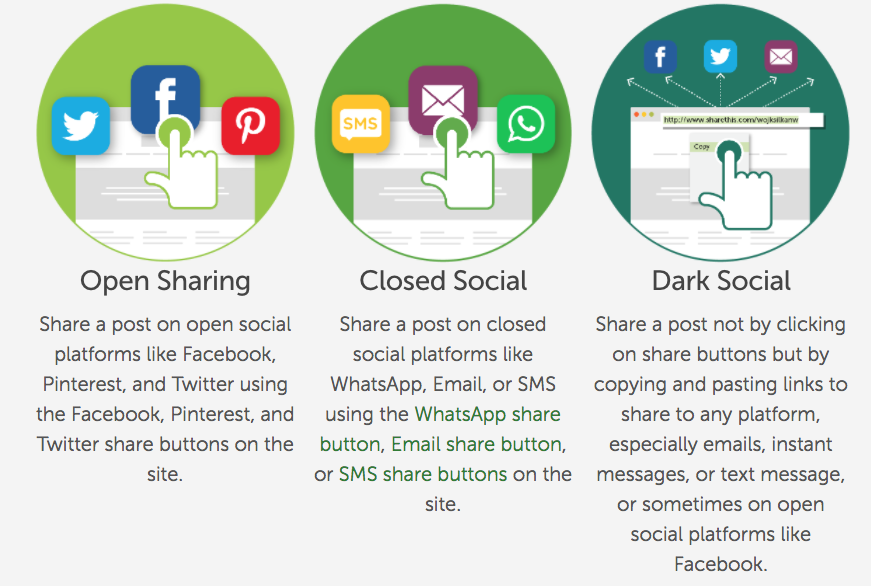Digital Transformation
Studying the Hidden World of Dark Social Engagement
There’s a hidden world of social sharing that often gets overlooked. For every tweet, pin, and Facebook link, there are certain shares that people have struggled to measure for years. As brands and publishers push for better engagement and tangible ROI, unlocking this data has never been more important.
There are two main ways for readers to share content online: use a share button or copy and paste the link. The first one is easy to track; the second isn’t. In 2012, Atlantic deputy editor Alexis Madrigal came up with the term “dark social” to describe the “vast trove of social traffic is essentially invisible to most analytics programs.” Per RadiumOne, 84 percent of sharing from publisher and marketing websites now takes place via private dark social channels such as email and instant messaging.
Here’s where it gets a little tricky. The rise of chat apps has led to more social sharing between individuals and small groups. There are different types of dark data, which has made engagement even harder to track.

At ShareThis, we decided to address this metrics challenge. Through our javascript code, embedded on millions of websites, we are able to track dark social shares. We recently dug into 113 million shares—across open, closed, and dark channels—to better understand how user behavior varies.
Here’s a preview of what we found.
The personal vs. the persona
We’d like to think that what we choose to share is a reflection of who we are, but it’s not that simple. The data suggests there’s a discrepancy between the persona we present to the world on open social versus our deeper desires and interests reserved for private sharing.
Over dark social, the most popular content categories included business education, counseling services, self-help, religion, and medical conditions. In fact, content with intimate words such as “God,” “Lord,” and “love” were often shared via dark social.

When dark shares expressed positive sentiment, they often dealt with aspirational content. Users were linking to high-end luxury goods, party and holiday supplies, flowers, gifts, spas and beauty services, and gyms and health clubs.
Publishers and marketers in these fields could cut back on content if they only see a few shares per story. But according to the data, they may want to rethink that strategy. It could help to make sharing as easy as possible so readers don’t have to go dark. For example, you could create and customize private sharing buttons on your websites for email, SMS, and chat platforms like WhatsApp.
On open channels, however, the top categories emphasized entertainment and group activities. Popular topics from our research included rock music, left-wing politics, gaming, bars and nightclubs, and local news. Positive sentiment was reserved for social topics like bars and clubs, politics, and continued education.
We’d like to think that what we choose to share is a reflection of who we are, but it’s not that simple.
On closed social channels, people shared professional and self-improvement topics related to work, finance, troubled relationships, and bankruptcy. Closed social channels showed the highest positive sentiment towards fashion modeling, vehicle specs, baked goods, charities, and government grants.
As for specific brands, readers tend to use closed social channels to share finance content related to companies like Wells Fargo, Dow Jones, and JPMorgan Chase. This type of sharing tells us more about what consumers really want and need. Meanwhile, on open sharing platforms, discussion centered on brands such as Volkswagen, AMC, and ESPN, likely fueling the water-cooler discussions safe to talk about without fear of embarrassment.
Dark devices
People love to say we live in a mobile-first world, but most dark sharing happens on desktop devices. In fact, 58 percent of desktop sharing takes place through dark social because of email.
Even though copying and pasting is a bit more difficult on a mobile device than a desktop, dark social still accounts for more than a quarter of all mobile sharing. But the majority of mobile users primarily use open social channels like Facebook and Twitter, where they like to share content on politics, news, and entertainment.

Location seems to play an important role in how we share. People may use dark social on desktops because they’re at work. In this environment, using open channels like Facebook and Twitter could be frowned up, but employees still have the opportunity to share content via email.
Still, those who do share on closed social mobile channels (like SMS text and WhatsApp) copy and paste their links rather than clicking on trackable sharing buttons. Implementing these buttons will empower users to share privately, but in a way that can still track activity. Because as it stands now, the gap is wide with 26 percent of shares coming from dark social compared to 2 percent from closed social.
As chat apps pull in more people around the globe, publishers who deploy mobile-friendly share buttons for the WhatsApps of the world will likely bring more of that darkness to light.
Out of the dark
Dark social is too big to ignore. These shares may have once eluded publishers, but with the right tools, they can unearth insights to study how audiences spread their favorite content.
Still, this data is only the beginning of what we found. In our new report, we uncover how people use open, closed, and dark social sharing for major events, across countries, and on different days of the week.
Click here to download the full report on the world of dark social.
Paul Lentz is the SVP of publisher & business operations at ShareThis, a technology company that provides free sharing and content optimization tools to more than three million publishers.
Image by iStockphotoGet better at your job right now.
Read our monthly newsletter to master content marketing. It’s made for marketers, creators, and everyone in between.




